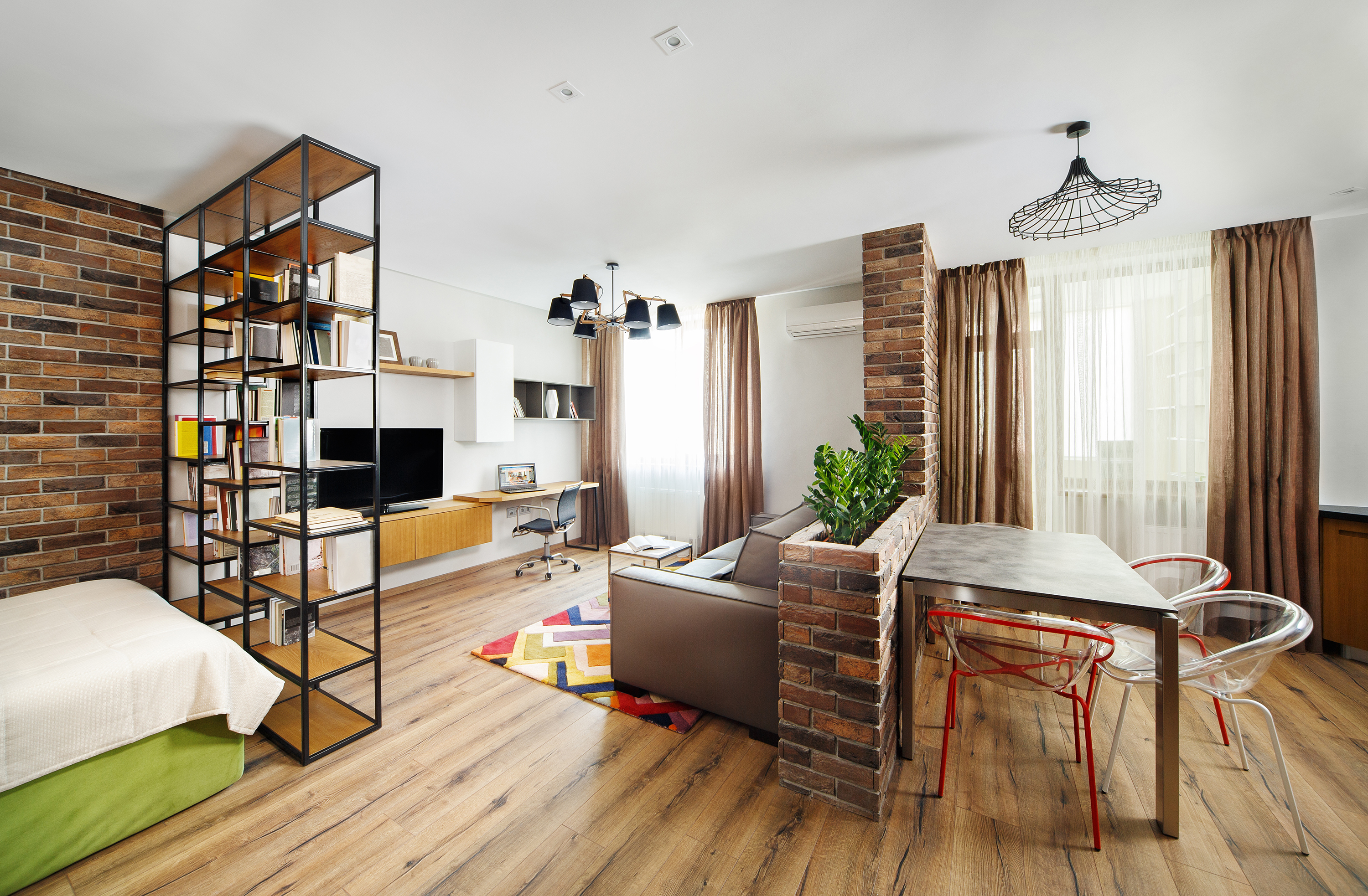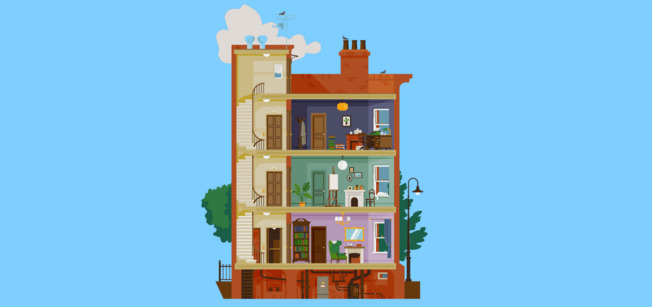
What is a Studio Apartment? The Definition, Pros & Cons
If you're searching for an apartment on a budget, especially in a city with high apartment prices, you may want to consider renting a studio apartment. In this article, we answer the question “What is a studio apartment?” We also explain how it compares to a one-bedroom, a loft, and more.
What is a studio apartment?
The answer to the question of “what is a studio apartment?” comes down to the number of rooms, or lack thereof. Studio apartments include only a single large room, plus a bathroom (and a closet if you're lucky). There's no separate bedroom, kitchen, or kitchenette in a studio. Instead, a studio is a single room with a kitchen area (rather than a separate kitchen) along a wall incorporated into the main living space.
Thankfully, studios do include a separate bathroom. With only one living space that doubles as the main living area and sleeping space, it should come as no surprise that studio apartments tend to be on the smaller side. The monthly rent also tends to be on the cheaper side — especially if the rent includes utility bills. A studio apartments' average size is approximately 600 square feet, though larger studios do exist. For the sake of comparison, that's roughly the same size as a three-car garage. Note that in some crowded cities such as New York City, the square footage can be as small as 200 square feet in a studio apartment.
What is an alcove studio vs. an L-shaped studio?
Studio apartments feature floor plans that include one room serving as the bedroom, living room, and kitchen area. The floor plans can vary depending on the building's age and architecture. Studios in newer apartment buildings may feature larger closets, storage spaces, or kitchen areas.
Regardless of the age of the building, not all studio floor plans are in the shape of a square or rectangle, which can be beneficial if you're looking for the illusion of separation. For example, the floor plan might be an L-shape or have an alcove. An L-shaped or alcove floor plan allows tenants to put their bed in a separate area that "feels" like it's away from the main living space. This can also free up room to have a larger table or dining area.
What is a loft apartment vs. a studio?
Sometimes you'll find a separate loft you can use as a sleeping area in a studio apartment. However, that doesn't mean it's a "loft apartment." Loft apartments differ from studio apartments in that their floor plans include large, open spaces with high ceilings. These apartments are often found in converted industrial buildings where tenants can expect to see exposed support structures, beams, and pipes. Loft apartments also usually include a separate room for the bedroom.
What is a studio apartment vs. a one-bedroom?
While studios and one-bedroom apartments can appeal to the same type of renters (typically those who live alone), there is one main difference: As the name suggests, a one-bedroom apartment features a separate room designated as the bedroom. One-bedroom apartments also generally offer more space than studio apartments. You'll also find that on average, studio apartments have cheaper rents than one-bedroom apartments. If you plan to move with another person, a one-bedroom apartment will likely be more suitable than a studio apartment. Of course, if you can afford it, a two-bedroom apartment would be even better. We calculated how much it would cost to upgrade from a studio apartment to a 1-bedroom apartment in many large U.S. cities.
What is a studio apartment vs. a micro apartment?
Studio and micro-apartments are similar to each other in layout, but not size. They each feature an all-in-one room, including a kitchen area, sleeping area, and living room. However, micro-apartments are significantly smaller than studios — their average square feet is between 200 and 400. If you're looking at a 300 square-foot micro-apartment, the square footage equates to about 30 square feet of sleeping area and approximately 60 square feet for living, cooking and dining.
What is a studio apartment vs. an efficiency apartment?
Even though people often use the terms studio and efficiency apartments in real estate interchangeably, there are differences between the two types of apartments. For example, there's typically separation between the kitchen and main living space in an efficiency apartment. And, instead of the full-size appliances that you'll find in a studio apartment, efficiency apartments feature compact appliances. Instead of a stove, you might find a cooktop with a small convection oven. The counter spaces and sinks also tend to be smaller in efficiency apartments.
What to Look for in a Studio Apartment
While small-space living can be appealing, here are some things to consider when choosing a studio apartment:
- High ceilings: The more vertical space you have, the more layered shelving and hanging space you have. Higher ceilings can give you a more spacious feeling.
- Windows: Natural light can help make a small space feel airier. If a studio is dark, it can feel more cramped.
- Full-sized appliances: Just because you're renting a smaller apartment, that doesn't mean you need to sacrifice the size of your appliances — by definition, studio apartments do not require you to forego standard-size appliances.
- Closet: Even if it's small, you'll need a closet to hang clothes and store personal items.
- Storage in the building: Moving into a smaller space means it must remain clutter-free — look for on-site storage in the building's basement or parking garage where you can stow items not currently in use.
- Common areas: Is there a roof deck or other outdoor space that you can use if you need a change of scene?
The Pros of Living in a Studio
Fans of the tiny house movement made popular by home magazines and TV shows know that there are benefits to living in a small space like a studio apartment. Here are just a few of the pros of living in a studio:
- Less to furnish: Open floor plans in smaller spaces don't require as much furniture. That's beneficial for first-time renters who don't have much furniture since furnishing a larger apartment can be pricy.
- Price/affordability of rent: One of the best advantages of a studio apartment is its affordability. Studios usually have lower rents and, because they're small, you also won't have to pay as much for utility bills.
- No space for visitors/out-of-town guests: If you prefer keeping your living space private and don't particularly enjoy hosting guests, a studio apartment can be just the excuse you need to keep visitors at bay.
- Cleaning is easy: When there's less square footage, there's less to clean. Because there isn't as much space for furniture or clutter, studio apartments are easy to maintain. With just one room, you can get your cleaning done in no time.
- Environmentally friendly: Living in a smaller space makes less of an impact on the environment. Smaller spaces require fewer construction materials to build and less furniture to furnish which inhibits your retail consumption. Thanks to the limited square footage, studio apartments also use less energy to heat and cool.
The Cons of Living in a Studio
If you subscribe to the idea that you should keep your bedroom a sanctuary reserved only for sleep, studio living may not be for you. Here are a few cons of studio life:
- Not ideal for more than one occupant: If you want a roommate, there might not be enough square footage to accommodate them. The same is true for couples who are looking for some elbow room.
- Too cramped for big pets: With limited space, a studio apartment may not be the best option if you live with a large breed dog. However, if you have a small dog or a cat, that might be more feasible. Since finding a pet-friendly apartment (studio or otherwise) can add an extra level of difficulty to your apartment search, be sure to give yourself plenty of time to find what you're looking for.
- No separate office space: Those who work or study from home may prefer a separate office space. Some people find it difficult to remain focused and efficient when they work, eat, and sleep all in the same one room. With a proper bedroom, it can be easier to create separation between your work and your personal life.
- Lack of walk-in closet and storage: Space constraints, such as a lack of storage or walk-in closets, can be problematic for some people (clothes hounds and keep-everything types, you know who you are). Limited storage and closets can be particularly challenging if you're moving from a larger home or apartment into a studio.
- Less space overall: If you're already used to living in a home or apartment with large rooms, the lack of space in a studio apartment may take some getting used to. While some find it cozy, others find all-in-one living spaces a bit too close for comfort.
- No space for visitors/out of town guests: If you enjoy hosting out-of-town guests, that can be less comfortable in a studio apartment. While studio living isn't ideal for extended overnight visitors, space-saving solutions can help. For example, perhaps a trundle bed is in your future?
Tips for Setting Up Your Studio Apartment
There are plenty of clever ways to create separation within your studio. Here are some tips on how to furnish open spaces and make distinct living areas within small spaces:
- Dividers: Create division within the space using screens, curtains, rugs, storage units, and other furniture.
- Double-duty solutions: Storage cubes that double as furniture are a great way to stow things out of view while simultaneously serving as seating, side tables, or even a makeshift desk.
- Less is more: Avoid over-filling the room with large furniture pieces or clutter — think, minimalist décor. Many retailers offer small-scale apartment size furniture perfect for urban dwellers with limited square footage.
- Use casters: Put casters on the legs of coffee tables, chairs, and storage cubes so you can slide them out of the way as needed. Side note: Look for dining chairs without arms since they take up less space and are easier to stack.
- Re-purpose: If you are lucky enough to find a studio apartment with a large closet, consider putting a desk in it, transforming part of it into a work or study zone.
- Convertible furniture: Use kitchen tables with sides that flip down when not in use and Murphy beds to create extra room in your living space when not sleeping.
The Bottom Line
Now that you know the difference between a traditionally shaped studio apartment, an L-shaped studio, an alcove studio, one with a loft, and other types of small rental options, apartment hunting should be a lot simpler. As you embark on your studio apartment search, be sure to check out our Apartment Tour Checklist highlighting the 17 things to look for in your next rental.
Top cities
Atlanta Apartments
1,591 apartments starting at $700/month
Austin Apartments
4,300 apartments starting at $600/month
Baltimore Apartments
1,281 apartments starting at $475/month
Boston Apartments
4,839 apartments starting at $425/month
Charlotte Apartments
2,723 apartments starting at $700/month
Chicago Apartments
5,884 apartments starting at $638/month
Dallas Apartments
5,495 apartments starting at $668/month
Fort Worth Apartments
2,569 apartments starting at $500/month
Houston Apartments
5,234 apartments starting at $595/month
Las Vegas Apartments
1,088 apartments starting at $745/month
Los Angeles Apartments
11,320 apartments starting at $642/month
Miami Apartments
601 apartments starting at $923/month
Milwaukee Apartments
1,144 apartments starting at $545/month
New York Apartments
4,733 apartments starting at $1,000/month
Oakland Apartments
793 apartments starting at $850/month
Orlando Apartments
855 apartments starting at $800/month
Philadelphia Apartments
2,876 apartments starting at $500/month
Phoenix Apartments
4,225 apartments starting at $631/month
Pittsburgh Apartments
785 apartments starting at $600/month
Portland Apartments
2,063 apartments starting at $649/month
Raleigh Apartments
1,195 apartments starting at $700/month
San Antonio Apartments
3,529 apartments starting at $500/month
San Diego Apartments
2,598 apartments starting at $650/month
San Francisco Apartments
479 apartments starting at $830/month
San Jose Apartments
433 apartments starting at $1,150/month
Seattle Apartments
2,988 apartments starting at $695/month
Tampa Apartments
792 apartments starting at $800/month
Washington DC Apartments
2,294 apartments starting at $910/month


